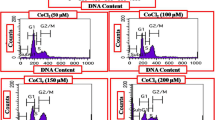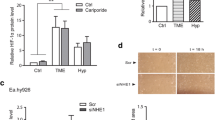Abstract
Angiogenesis is an essential process for the establishment, development, and dissemination of several malignant tumors including bladder cancer. The hypoxic condition promotes the stabilization of hypoxia-inducible factor 1 alpha (HIF-1α), which translocates to the nucleus to mediate angiogenic factors including the vascular endothelial growth factor A (VEGF-A). AnaeroGen system was developed for microbiology area to create a low oxygen tension required to the growth of anaerobic bacteria. Here, we hypothesized the use of AnaeroGen system to induce hypoxia in T24 human bladder carcinoma cells, in order to promote the overexpression of VEGF-A. T24 cells were cultured in six-well plates containing McCoy medium. Exposures of T24 cells to hypoxia for 1, 8, 24, and 48 h were performed using the Oxoid AnaeroGen system, while T24 cells under normoxia were used as control. The expression of VEGF-A and HIF-1α was analyzed by real-time PCR. ELISA for HIF-1α was carried out. The VEGF-A expression increased significantly by Oxoid AnaeroGen-induced hypoxia in a time-depending manner, reaching the peak in 48 h of hypoxia. Although HIF-1α mRNA was not changed, HIF-1α protein was increased in the presence of hypoxia, reaching a peak at 8 h. These results demonstrated that the Oxoid AnaeroGen system is a simple method to expose T24 cells to hypoxia and efficiently to upregulate VEGF expression in T24 cells.





Similar content being viewed by others
References
Ajili F, Kacem M, Tounsi H, Darouiche A, Enayfer E, Chebi M et al (2012) Prognostic impact of angiogenesis in nonmuscle invasive bladder cancer as defined by microvessel density after immunohistochemical staining for CD34. Ultrastruct Pathol 36(5):336–342
Amantini C, Morelli MB, Santoni M, Soriani A, Cardinali C, Farfariello V, Eleuteri AM, Bonfili L, Mozzicafreddo M, Nabissi M, Cascinu S, Santoni G (2015) Sorafenib induces cathepsin B-mediated apoptosis of bladder cancer cells by regulating the Akt/PTEN pathway. The Akt inhibitor, perifosine, enhances the sorafenib-induced cytotoxicity against bladder cancer cells. Oncoscience 2(4):395–409
Barliya T, Mandel M, Livnat T, Weinberger D, Lavie G (2011) Degradation of HIF-1alpha under hypoxia combined with induction of Hsp90 polyubiquitination in cancer cells by hypericin: a unique cancer therapy. PLoS One 6(9):e22849
Bernardini S, Fauconnet S, Chabannes E, Henry PC, Adessi G, Bittard H (2001) Serum levels of vascular endothelial growth factor as a prognostic factor in bladder cancer. J Urol 166:1275–1279
Chen MC, Hsu WL, Hwang PA, Chou TC (2015) Low molecular weight fucoidan inhibits tumor angiogenesis through downregulation of HIF-1/VEGF signaling under hypoxia. Mar Drugs 13(7):4436–4451
Crew JP, O’Brien T, Bradburn M, Fuggle S, Bicknell R, Cranston D et al (1997) Vascular endothelial growth factor is a predictor of relapse and stage progression in superficial bladder cancer. Cancer Res 57:5281–5285
Fechner G, Dederichs F, Schmidt D, Müller S, Vaupel P, Albers P (2005) Hyperoxia-induced improvement of the in vitro response to gemcitabine in transitional cell carcinoma. Anticancer Res 25(5):3413–3418
Hollosi P, Yakushiji JK, Fong KS, Csiszar K, Fong SF (2009) Lysyl oxidase-like 2 promotes migration in noninvasive breast cancer cells but not in normal breast epithelial cells. Int J Cancer 125(2):318–327
Huang LE, Arany Z, Livingston DM, Bunn HF (1996) Activation of hypoxia-inducible transcription factor depends primarily upon redox-sensitive stabilization of its alpha subunit. J Biol Chem 271(50):32253–32259
Imhof A, Heinzer I (1996) Continuous monitoring of oxygen concentrations in several systems for cultivation of anaerobic bacteria. J Clin Microbiol 34(7):1646–1648
Jones A, Fujiyama C, Blanche C, Moore JW, Fuggle S, Cranston D et al (2001) Relation of vascular endothelial growth factor production to expression and regulation of hypoxia-inducible factor-1 alpha and hypoxia-inducible factor-2 alpha in human bladder tumors and cell lines. Clin Cancer Res 7(5):1263–1272
Koga F, Tsutsumi S, Neckers LM (2007) Low dose geldanamycin inhibits hepatocyte growth factor and hypoxia-stimulated invasion of cancer cells. Cell Cycle 6(11):1393–1402
Liu AG, Zhang XZ, Li FB, Zhao YL, Guo YC, Yang RM (2013) RNA interference targeting adrenomedullin induces apoptosis and reduces the growth of human bladder urothelial cell carcinoma. Med Oncol 30(3):616
Maxwell PH, Wiesener MS, Chang GW, Clifford SC, Vaux EC, Cockman ME et al (1999) The tumour suppressor protein VHL targets hypoxia-inducible factors for oxygen-dependent proteolysis. Nature 399(6733):271–275
Miller PH, Wiggs LS, Miller JM (1995) Evaluation of AnaeroGen system for growth of anaerobic bacteria. J Clin Microbiol 33(9):2388–2391
Miyake M, Fujimoto K, Anai S, Ohnishi S, Kuwada M, Nakai Y et al (2011) Heme oxygenase-1 promotes angiogenesis in urothelial carcinoma of the urinary bladder. Oncol Rep 25(3):653–660
Palit V, Phillips RM, Puri R, Shah T, Bibby MC (2005) Expression of HIF-1alpha and Glut-1 in human bladder cancer. Oncol Rep 14(4):909–913
Ritter MR, Moreno SK, Dorrell MI, Rubens J, Ney J, Friedlander DF, Bergman J et al (2014) Cancer statistics. CA Cancer J Clin 64(1):9–29
Salceda S, Caro J (1997) Hypoxia-inducible factor 1alpha (HIF-1alpha) protein is rapidly degraded by the ubiquitin-proteasome system under normoxic conditions. Its stabilization by hypoxia depends on redox-induced changes. J Biol Chem 272(36):22642–22647
Sandes E, Lodillinsky C, Cwirenbaum R, Argüelles C, Casabé A, Eiján AM (2007) Cathepsin B is involved in the apoptosis intrinsic pathway induced by Bacillus Calmette-Guérin in transitional cancer cell lines. Int J Mol Med 20(6):823–828
Yang X, Li S, Li W, Chen J, Xiao X, Wang Y, Yan G, Chen L (2013) Inactivation of lysyl oxidase by β-aminopropionitrile inhibits hypoxia-induced invasion and migration of cervical cancer cells. Oncol Rep 29(2):541–548
Acknowledgments
We are sincerely grateful to Angela Batista Gomes dos Santos for her technical assistance.
Authors’ contributions
JMSC participated in the design of the study; performed the cell culture experiments, data analysis and interpretation, and statistical analysis; and drafted the manuscript. RBOB participated in the design of the study; performed the cell culture experiments; performed the real-time PCR experiments, data analysis and interpretation, and statistical analysis; and drafted the manuscript. CSM participated in the design of the study; performed the cell culture experiments; performed the real-time PCR experiments, data analysis and interpretation, and statistical analysis; and drafted the manuscript. CSS participated in the design of the study; performed the cell culture experiments, data analysis and interpretation, and statistical analysis; and drafted the manuscript. YM participated in the design of the study; performed the ELISA experiments, data analysis and interpretation, and statistical analysis; and drafted the manuscript. TCMK participated in the design of the study; performed the ELISA experiments, data analysis and interpretation, and statistical analysis; and drafted the manuscript. JJU performed data analysis and interpretation and drafted the manuscript. LVFO performed data analysis and interpretation and drafted the manuscript. MAD performed data analysis and interpretation of the ELISA for HIF-1α. HD participated in the design of the study, performed statistical analysis, performed data analysis and interpretation, and drafted the manuscript. All authors read and approved the final manuscript.
Author information
Authors and Affiliations
Corresponding author
Ethics declarations
Competing interest
The authors declare that they have no competing interest.
Disclosures
This work was supported by the São Paulo Research Foundation (FAPESP), grant 2016/04105-0.
Additional information
Editor: Tetsuji Okamoto
Rights and permissions
About this article
Cite this article
Cesário, J.M.S., Brito, R.B.O., Malta, C.S. et al. A simple method to induce hypoxia-induced vascular endothelial growth factor-A (VEGF-A) expression in T24 human bladder cancer cells. In Vitro Cell.Dev.Biol.-Animal 53, 272–276 (2017). https://doi.org/10.1007/s11626-016-0103-4
Received:
Accepted:
Published:
Issue Date:
DOI: https://doi.org/10.1007/s11626-016-0103-4




